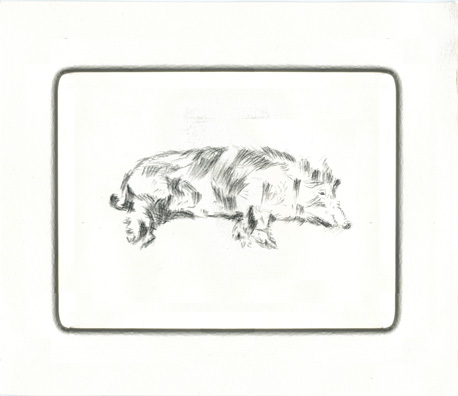Pig
(After Rembrandt)

This is a dry point engraving after a pig etching by Rembrandt Van Rijn. Dry point is the simplest method of intalgio printing. You simply scratch the image onto the plate. You then ink the plate and push the the ink into the scratched lines. Next you wipe off the plates removing the ink except for the ink that is in the lines.
Next you place your paper - previously wetted and excess water blotted off - onto the plate and run it through a special high pressure press. The paper is forced into the lines and pulls the ink off, and - hey, presto! - you have a nice fine-line print.
This was a very modern type engraving - the plate was not metal, but poly(methyl 2-methylpropenoate) - that is, plexiglass®.
Rembrandt's engravings, though, were not just made by drypoint. Much of it was by etching. That is a metal plate was coated with a ground - a light coating of asphaltum - asphault suspended in a volatile petroleum solvent - which leaves a waxy film on the plate. You then take a metal stylus - and scratch off the film to leave the drawing. Next Rembrandt would place the plate in an acid bath - nitric acid is what we use today - and after a few minutes, take it out, rinse it with water, and wash off the asphaltum film with the petroleum solvent. You can then ink, wipe, and print.
Naturally actual etchings use materials not recommended without proper safety equipment - including fume hoods, acid resistant gloves, and safety goggles - and proper instruction. Not that there aren't safety issues in drypoint. You can cut or poke yourself with the sharp tools.
The only problem with drypoint is you do need the proper presses. Something not often found in the home and even the table top models are not cheap. You can spend tens of thousands of dollars for a floor model which requires special installation which includes a strong arm and back.
Although etching and drypoint produce nice fine lines, the type of print most amendable to the home is block printing - made most famous by Japanese artists of the Middle Ages.
And for those who want to be shocked! shocked!, the actual artists who get the credit for the wood cuts, did not usually do the actual wood cutting. They drew the picture and it was transferred to the block and cut, inked, and printed by skilled block cutters and printers.